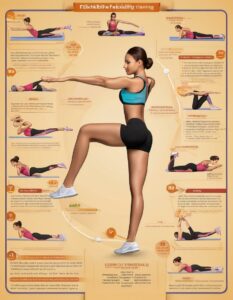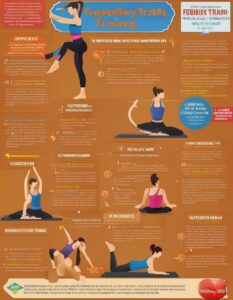

Flexibility is the muscle’s ability to stretch and give us the range of motion needed for day-to-day tasks, exercise, and sports. It’s not about being able to do splits at the drop of a hat but about maintaining the functionality and comfort of your body as you move it.
The spectrum of flexibility training extends from static stretches, where poses for a certain period, to dynamic stretches, which involve movement and prepare the body for activity. Ballistic stretching, involving bouncing movements to push muscles beyond their normal range, is generally not recommended due to its high risk of injury.
Understanding personal limits is vital. I know my body isn’t the same every day, and neither is yours. A warm-up, including light jogging or dynamic stretches, can prepare the muscles for deeper stretching and reduce the risk of strains or sprains.
Why bother with all of this? Because the rewards are substantial. Improved flexibility elevates your overall health, aids in injury prevention, and enhances the quality of athletic endeavors. Even simple, everyday movements can be easier and more efficient with a supple body.
As you’ve begun to appreciate the foundational elements of flexibility training, you might be curious about where you currently stand and how to move forward. In the next section, I’ll walk you through assessing your flexibility, crafting personal goals, and creating a framework for consistent progress.
Personalizing Your Flexibility Journey: Assessing Your Needs and Setting Goals
When it comes to enhancing your flexibility, it’s not a one-size-fits-all endeavor. Your current level of flexibility, lifestyle, age, and goals will steer your training course. Before you can leap forward, you need to know where you’re standing, and here’s how you do that.
Self-assessment is the starting block. You could be a beginner with a limited range of motion or someone with moderate flexibility looking to aim higher. Do some basic stretches and note the ease or difficulty you face. Be honest with yourself; it’s about knowing your baseline, not setting a world record.
With your current status in mind, it’s time to set stretch goals – and I mean that quite literally. Goals should be SMART: Specific, Measurable, Achievable, Relevant, and Time-bound. Maybe you’re aiming to touch your toes without bending your knees or working to master a full split. Chart a course that challenges you without setting you up for disappointment.
Flexibility training isn’t a sprint; it’s a gradual progression. It takes regular practice and time – think weeks or months, not days. Sticking to a schedule is critical. And it’s worth noting that flexibility can differ wildly among people. What works for a teenager might not suit someone in their fifties. Tailoring your approach is crucial.
Patience bears stretching success. If you’re older or less active, start with gentler stretches and progress more slowly. Your body will thank you. Likewise, if you’re younger or more active, you might progress faster but still need to avoid overdoing it.
Essential Flexibility Exercises: Building a Comprehensive Routine
A well-structured stretching routine targets various muscle groups and embraces different stretching techniques. Concentrating on major muscle groups such as the hamstrings, hips, back, and shoulders is essential. For each group, there are specific stretches I’ll guide you through.
Let’s draw attention to a specialized technique called Proprioceptive Neuromuscular Facilitation, or PNF for short. PNF is a series of stretching techniques that typically involve a stretch, a contraction, and a further stretch. This method is excellent for making quick gains in flexibility due to the muscular relaxation that occurs after contraction.
Integrating stretch sessions into your daily life can be effortless. Consider replacing sedentary activities with dynamic stretches or allocate time each morning for a brief static stretching routine. It’s about finding those small opportunities throughout your day for a quick stretch – while watching TV, after sitting for long hours, or post-workout.
Lastly, tools like straps, resistance bands, and foam rollers can significantly increase the effectiveness of your stretches. They help deepen the stretch, maintain proper alignment, and ease into challenging positions. Remember, using equipment is not cheating; it’s an intelligent way to work towards greater flexibility while minimizing the risk of injury.
Staying Safe and Motivated: Overcoming Challenges in Flexibility Training
Staying consistent with flexibility training can sometimes be an uphill battle. You might hit a plateau, get frustrated with slow progress, or even experience the occasional setback. But let’s not get discouraged. Everyone faces these hurdles, and the important thing is how you respond to them.
Let’s start with a simple truth: making mistakes is part of the learning process. Whether you’ve overestimated your limits or forgotten to warm up, what matters is that you recognize these slip-ups and take steps to avoid them in the future. Reflect on your routine, listen to your body, and adjust accordingly.
When you find your progress stalling, change it up. Add variations to your stretching routine, gradually increase the frequency or intensity, and ensure you’re giving your body the rest it needs to recover. Sometimes, seeking advice from a professional or joining a class can provide fresh insight and a much-needed boost.
The key to injury prevention is a balance between stretching and rest. Give yourself time to recover if you feel pain beyond a normal stretch discomfort. Rushing the process can do more harm than good. Remember, flexibility gains are marathons, not sprints.
Finally, keeping your motivation high can be as simple as setting smaller, interim goals to celebrate the small victories. Engage with a community of like-minded folks who can offer support, share their experiences, and cheer you on. Track your progress with photos or a stretching diary to see how far you’ve come.
Remember, the journey to becoming more flexible is unique to you. Embrace your pace, stay mindful of your body’s signals, and enjoy the process. Before you know it, the benefits of flexibility will unfold in your day-to-day life, proving that the effort is worth every stretch.
